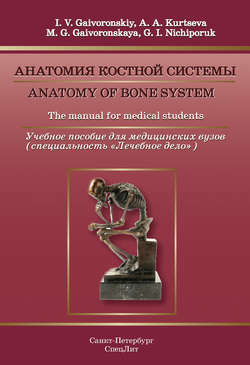Читать книгу Anatomy of bone system. The manual for medical students / Анатомия костной системы. Учебное пособие для медицинских вузов - Г. И. Ничипорук - Страница 23
2. SKELETON OF TRUNK
2.7. Anomalies and Developmental Defects of Vertebrae
ОглавлениеAnomalies and developmental defects may be classified according to the following criteria:
I. Vertebral size anomalies:
1. Microspondylia – reduction in size of one or more vertebrae.
2. Brachyspondylia – reduction in width of one or more vertebrae.
3. Platyspondylia – flattening of some vertebrae which get a truncated cone shape.
4. Macrospondylia – increase in size of some vertebrae.
II. Slit-like Defects of Vertebrae:
1. Splitting of vertebral bodies (anterior splitspine, spina bifida anterior) – a slit-like defect of the vertebral body located more often in the sagittal plane.
2. Splitting of the vertebral arch (posterior split spine, spina bifida posterior) – a slit-like defect of the vertebral arch (near a spinous process or on its place).
3. Spondylolysis – in this case, the vertebral body is not fused with the pedicles of the vertebral arch: this anomaly may be observed either on one or on both sides, it happens most often in the V lumbar vertebra or in the I sacral vertebra; in case of bilateral spondylolysis, the posterior part of the arch with the inferior articular processes are separated from the pedicles of the arch with the superior articular processes.
4. Spondylolisthesis – displacement of the body of the upper vertebra frontwards (very seldom – backwards relative to the lower vertebra. Most often it occurs after compressive fracture of a vertebral body when the vertebra becomes wedge-shaped.
5. Rachischisis – in this case the vertebral body is not fused with the pedicles of the vertebral arch, and the vertebral arch is splitted.
III. Development anomalies of individual vertebrae:
1. Assimilation of the atlas:
– atlanto-occipital assimilation (occipitalization) – partial or complete fusion of the I cervical vertebra with the occipital bone: two-sided (symmetric) or one-sided (asymmetric);
– atlantoaxial assimilation – partial or complete fusion of the I and II vertebrae.
2. Manifestation of the atlas (formation of the occipital vertebra – proatlas) –inclusion of the atlas particles into the occipital bone which is manifested in the presence of anomalous bony prominences in the circle of the great (occipital) foramen.
3. Kimmerle`s anomaly – transformation of the vertebral artery groove on the atlas into the canal as a result of formation of a bony outgrowth above this groove.
4. Development anomalies of the II cervical vertebra:
– agenesia (absence) of the dens;
– the dens and the body of the II cervical vertebra are not fused together.
5. Thoracolisation of the cervical vertebrae – formation of cervical ribs (most often from the VII cervical vertebra).
6. Sacralisation – fusion of the V lumbar vertebra with the I sacral vertebra: there are 4 vertebrae in the lumbar part of the vertebral column; the sacrum consists of 6 vertebrae.
7. Lumbarisation – the I sacral vertebra and the II sacral vertebra are not fused together: there are 6 vertebrae in the lumbar part of the vertebral column; the sacrum consists of 4 vertebrae.
